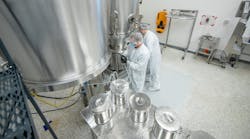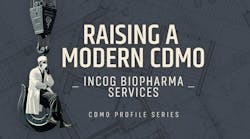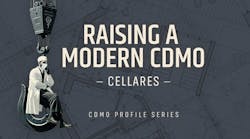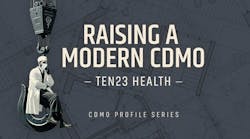Globally, the demand for pharmaceutical products has been steadily increasing as the world’s population ages and the healthcare standards in developing countries rise. In response to market trends, the landscape for contract development and manufacturing organisations (CDMOs) is changing to meet evolving customer expectations.
The CDMO industry is currently a very fragmented space; the top five companies own less than a 15 percent share of the market. In comparison to the contract research organisation (CRO) market, in which the top five largest companies own 70 percent.[1]This is beginning to change however, as more mergers and acquisitions (M&A) take place across the CDMO sector, with significant consolidation expected in the next few years. This is in line with the preferences of many pharmaceutical companies; more and more customers are choosing to outsource to one full-service CDMO rather than several niche providers, as this simplifies the supply chain and can reduce time to market. In addition, to help bolster and expand their capabilities, many larger CDMOs are acquiring smaller, niche facilities in multiple locations, a trend we will see continue.
In terms of drug development, there is also greater demand for complex formulations. New technologies and development techniques are emerging, meaning controlled release and fixed dose combinations are becoming more achievable. Misuse and abuse deterrent technologies are also progressing, with novel solutions beginning to enter the market. These advances are likely to lead to greater patient adherence and safety.
In this article, Mark Quick at Recipharm discusses emerging and continuing trends that the CDMO industry is likely to experience. He also advises on how those in the outsourcing sector can be more prepared to meet shifting customer demands as the industry continues to evolve.
The CDMO market: Emerging and continuing trends
In recent years, the pharmaceutical market has experienced a lot of change, which has significantly impacted the CDMO sector and demand for its services. With the pharma industry worth $1.2 trillion in 2018, IQVIA predicts that it will be worth over $1.5 trillion by 2023.[2]
Many pharmaceutical companies are seeking advanced supply chain opportunities in order to optimize the development of their molecule. This has led to a lot of firms establishing a partnership with a CDMO as opposed to investing internally on infrastructure.
Another key trend in the outsourcing sector is the proliferation of M&A strategies. Research has found that M&A activity has been accelerating since 2012, increasing approximately 12 percent each year.[1] As such, we are likely to see more consolidation of CDMOs throughout 2019 in order to facilitate supply chain efficiencies, improve lead times, expand geographical reach and advance capabilities.
Industry consolidation has been partly driven by the desire to diversify capabilities, so that CDMOs can effectively provide customers with comprehensive end-to-end drug development and manufacturing services, whilst also reducing operational costs. This is because drug developers are keen to progress their drug product to market as quickly as possible, with minimal supply chain complexity. Additionally, changing service providers mid-development incurs heavy expenditure and so full-service providers are often seen as way to decrease overall costs for drug developers.
Another factor impacting the proliferation of M&A strategies is the current fragmented state of the sector; as manufacturing activity continues to be actively outsourced, companies are consolidating in a bid to meet customer demand and maintain a successful position within the sector. In acquiring new technologies and capabilities, contract service providers can streamline their overall service spanning drug development to commercial product.
By acquiring new facilities, companies can expand their global presence and reach new markets. Although there are many opportunities available within the European market, it does present some challenges such as the need to cater for a diverse range of packaging variations as a result of varying legislation and the vast amount of languages spoken across the continent. In contrast, the US provides many operational and market benefits. For example, the U.S. landscape offers companies a common language and legislative requirements for around 300 million citizens, which ultimately lessens the likelihood of experiencing any logistical issues. Outsourcing to a CDMO with experience and a presence in both markets can help to manage this complexity.
In addition, an emerging market that is increasingly sought after is India. This is because it has a reputably skilled workforce and can offer companies more cost efficiency as opposed to western countries. Moreover, India has secured 34 percent of all Abbreviated New Drug Applications (ANDAs) and received a total 1,842 ANDA final approvals by U.S. Food and Drug Administration (FDA) in the period between 2009 to 2018,which further solidifies its position as a strong market. CDMOs are already starting to build their presence in this growing market and this trend is expected to continue.
Drug development
A primary drug development trend is the use of the 505(b)(2) new drug applications (NDA) pathway. It is growing in popularity amongst pharmaceutical drug manufacturers due to the efficient route to market it offers new drugs as a result of companies being able to reuse existing data for well-understood APIs. The 505(b)(2) pathway has sparked an interest in the development techniques available for orally inhaled products and nasal sprays, such as spray drying. Thus, it is expected that demand for inhalation services will increase as drug developers explore efficient delivery routes to facilitate enhanced therapeutic effects for patients.
In addition, following the increasing concerns around prescription drug abuse, global regulators have recommended that drug developers ensure that certain products contain technologies in order to minimize abuse, particularly those including opioids [4/5]. This notion has impacted formulation development as it has encouraged pharmaceutical companies to develop technologies that will prevent the API being released through drug product manipulation.
How to prepare in an evolving CDMO landscape
Of course, in a shifting regulatory environment with evolving customer demands, CDMOs must always be thinking about what is next. A recent case in point was the enforcement of the EU Falsified Medicines Directive (FMD) regulation in February 2019.
Pharmaceutical firms should also seek to invest in their sustainability efforts in order to maintain compliance and be prepared for tightening requirements in the future.
Going forward, the emergence of precision medication will require CDMOs to adjust their manufacturing strategies and processes. As such, contract service providers will need to be able to potentially distribute smaller and personalized batches alongside larger volumes. CDMOs can prepare for these new drug pipeline requirements by adapting and ensuring they are agile and flexible in their approach.
Conclusion
As the CDMO market continues to evolve, pharmaceutical companies will be exposed to new opportunities and demands throughout the year. Both consolidation and the emergence of new technologies are enabling companies to innovate new and existing drugs, while also improving the customer experience, reducing timelines and costs.
References
1. https://bit.ly/2QNpjVj(Kurmann Partners Pharma M&A Report 2018)
2. IQVIA Institute for Human Data Science: The Global Use of Medicine in 2019 and Outlook to 2023
3. https://go.ey.com/2HZGph1(EY Report 2017)
4. https://www.fda.gov/downloads/Drugs/.../Guidances/UCM492172.pdf
5. http://www.ema.europa.eu/docs/en_GB/document_library/Scientific_guideline/2015/12/WC500199242.pdf





